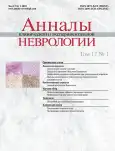Assessing trigeminal microstructure changes in patients with classical trigeminal neuralgia
- Authors: Rozhnova E.N.1, Dashyan V.G.1,2, Tokarev A.S.1, Evdokimova O.L.1, Neznanova M.V.1, Sinkin M.V.1,2
-
Affiliations:
- N.V. Sklifosovsky Research Institute for Emergency Medicine
- A.I. Yevdokimov Moscow State University of Medicine and Dentistry
- Issue: Vol 17, No 1 (2023)
- Pages: 20-26
- Section: Original articles
- URL: https://journals.rcsi.science/2075-5473/article/view/125983
- DOI: https://doi.org/10.54101/ACEN.2023.1.3
- ID: 125983
Cite item
Full Text
Abstract
Introduction. The crucial role of neuro-vascular conflict (NVC) in trigeminal neuralgia (TN) is getting increasingly challenged. Microstructural changes can be assessed using fractional anisotropy (FA) in diffusion tensor images (DTI).
Objective. To evaluate usefulness of FA in brain MRI with DTI for TN lateralization assessment.
Materials and methods. The study included 51 patients with classical TN divided into two groups: neurosurgical intervention free, post radiofrequency ablation (RFA), and a control group (patients without facial pain). All the patients were tested for NVC with FIESTA (Fast Imaging Employing Steady State Acquisition) brain MRI at 3Т. Difference in thickness of trigeminal roots on the intact and symptomatic sides was assessed for each group. The findings were compared to those in the control group. The MRI protocol was supplemented with DTI. The FA difference in thickness of the intact and symptomatic roots (∆FA) was calculated for each study group to assess microstructural root changes. The results were compared to those in the control group.
Results. In trigeminal root DTIs, ∆FA over 0.075 [0.029; 0.146] is statistically significant to establish NVC-associated microstructural changes on the symptomatic side in patients without any past surgeries (p = 0,030). In patients with a history of trigeminal ganglion RFA, statistically significant (p = 0.026) thinned symptomatic trigeminal root (difference in thickness of trigeminal roots over 0.45 cm [0.4; 0.6]) was found as compared to that of the control patients.
Conclusion. ΔFA may be used as a quantitative demyelination biomarker in clinical TN. Trigeminal ganglion RFA leads to hypotrophy throughout the trigeminal nerve root.
Full Text
##article.viewOnOriginalSite##About the authors
Elizaveta N. Rozhnova
N.V. Sklifosovsky Research Institute for Emergency Medicine
Author for correspondence.
Email: elizabett-eliz@yandex.ru
ORCID iD: 0000-0003-0521-4836
SPIN-code: 1803-3451
Scopus Author ID: 57243798700
Neurologist
Russian Federation, MoscowVladimir G. Dashyan
N.V. Sklifosovsky Research Institute for Emergency Medicine; A.I. Yevdokimov Moscow State University of Medicine and Dentistry
Email: v485@bk.ru
ORCID iD: 0000-0002-5847-9435
SPIN-code: 7353-7768
Scopus Author ID: 56298034600
D. Sci. (Med.), Senior Researcher, Neurosurgeon. N.V. Sklifosovsky Research Institute of Emergency Medicine; Professor, A.I. Yevdokimov Moscow State University of Medicine and Dentistry
Russian Federation, Moscow; MoscowAleksey S. Tokarev
N.V. Sklifosovsky Research Institute for Emergency Medicine
Email: tokarev@neurosklif.ru
ORCID iD: 0000-0002-8415-5602
SPIN-code: 1608-0630
Scopus Author ID: 56559651400
Cand. Sci. (Med.), Neurosurgeon, N.V. Sklifosovsky Research Institute of Emergency Medicine
Russian Federation, MoscowOlga L. Evdokimova
N.V. Sklifosovsky Research Institute for Emergency Medicine
Email: liveryevna@yandex.ru
ORCID iD: 0000-0001-8099-9544
SPIN-code: 8357-7392
Scopus Author ID: 57212801333
Radiologist, Head, Radiosurgery Center, N.V. Sklifosovsky Research Institute of Emergency Medicine
Russian Federation, MoscowMaria V. Neznanova
N.V. Sklifosovsky Research Institute for Emergency Medicine
Email: mashaneznanova@inbox.ru
ORCID iD: 0000-0002-0635-6783
SPIN-code: 3003-1528
Scopus Author ID: 57221967771
Radiologist, N.V. Sklifosovsky Research Institute of Emergency Medicine
Russian Federation, MoscowMikhail V. Sinkin
N.V. Sklifosovsky Research Institute for Emergency Medicine; A.I. Yevdokimov Moscow State University of Medicine and Dentistry
Email: mvsinkin@gmail.com
ORCID iD: 0000-0001-5026-0060
SPIN-code: 2114-6130
Scopus Author ID: 12775157800
D. Sci. (Med.), Senior Researcher, Neurologist, N.V. Sklifosovsky Research Institute of Emergency Medicine; Head, Laboratory of Invasive Neurointerfaces, A.I. Yevdokimov Moscow State University of Medicine and Dentistry
Russian Federation, Moscow; MoscowReferences
- Bendtsen L., Zakrzewska J.M., Abbott J. et al. European Academy of Neurology guideline on trigeminal neuralgia. Eur. J. Neurol. 2019; 26(6): 831–869. doi: 10.1111/ene.13950
- Sindou M., Howeidy T., Acevedo G. Anatomical observations during microvascular decompression for idiopathic trigeminal neuralgia. Prospective study in a series of 579 patients. Acta Neurochir. (Wien). 2002; 144(1): 1–13. doi: 10.1007/s701-002-8269-4
- Mukherjee P., Chung S.W., Berman J.I. et al. Diffusion tensor MR imaging and fiber tractography: technical considerations. AJNR Am. J. Neuroradiol. 2008; 29(5): 843–852. doi: 10.3174/ajnr.A1052
- Tournier J.D., Mori S., Leemans A. Diffusion tensor imaging and beyond. Magn. Reson. Med. 2011; 65(6): 1532–1556. doi: 10.1002/mrm.22924
- Lutz J., Thon N., Stahl R. et al. Microstructural alterations in trigeminal neuralgia determined by diffusion tensor imaging are independent of symptom duration, severity, and type of neurovascular conflict. J. Neurosurg. 2016; 124(3): 823–830. doi: 10.3171/2015.2.JNS142587
- Herweh C., Kress B., Rasche D. et al. Loss of anisotropy in trigeminal neuralgia revealed by diffusion tensor imaging. Neurology. 2007; 68(10): 776–778. doi: 10.1212/01.wnl.0000256340.16766.1d
- Liu Y., Li J., Butzkueven H. et al. Microstructural abnormalities in the trigeminal nerves of patients with trigeminal neuralgia revealed by multiple diffusion metrics. Eur. J. Radiol. 2013; 82(5): 783–786. doi: 10.1016/j.ejrad.2012.11.027
- Fujiwara S., Sasaki M., Wada T. et al. High-resolution diffusion tensor imaging for the detection of diffusion abnormalities in the trigeminal nerves of patients with trigeminal neuralgia caused by neurovascular compression. J. Neuroimaging. 2011; 21(2): e102–108. doi: 10.1111/j.1552-6569.2010.00508.x
- Leal P.R.L., Roch J., Hermier M. et al. Diffusion tensor imaging abnormalities of the trigeminal nerve root in patients with classical trigeminal neuralgia: a pre- and postoperative comparative study 4 years after microvascular decompression. Acta Neurochir. (Wien). 2019; 161(7): 1415–1425. doi: 10.1007/s00701-019-03913-5
- Dandy W.E. Concerning the cause of trigeminal neuralgia. Am. J. Surg. 1934; 24(2): 447–455. doi: 10.1016/S0002-9610(34)90403-7
- Adams C.B. Microvascular compression: an alternative view and hypothesis. J. Neurosurg. 1989; 70(1): 1–12. doi: 10.3171/jns.1989.70.1.0001
- Miller J.P., Acar F., Hamilton B.E., Burchiel K.J. Radiographic evaluation of trigeminal neurovascular compression in patients with and without trigeminal neuralgia. J. Neurosurg. 2009; 110(4): 627–632. doi: 10.3171/2008.6.17620
- Lee A., McCartney S., Burbidge C. et al. Trigeminal neuralgia occurs and recurs in the absence of neurovascular compression. J. Neurosurg. 2014; 120(5): 1048–1054. doi: 10.3171/2014.1.JNS131410
Supplementary files













